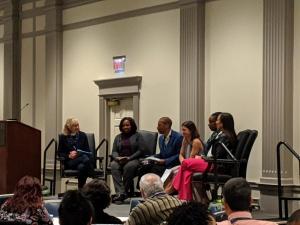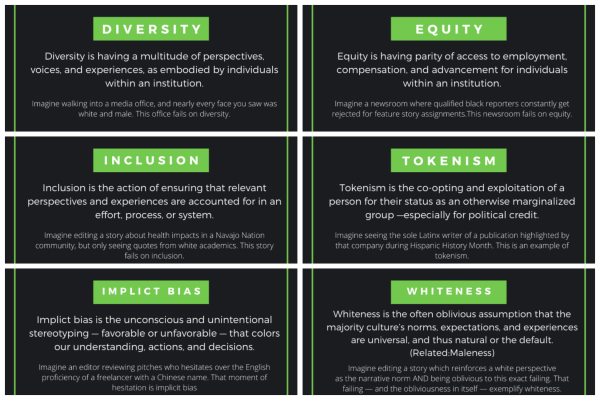By Danya AbdelHameid

(Credit: Danya AbdelHameid)
“We want to convince you all that no matter your background or ethnicity, diversity and inclusion matters to all of us in science journalism and science writing,” said Clinton Parks, a D.C.-based freelance writer and one of the three session organizers. “And most importantly, it matters to the people we serve.”
The session, titled, “How Can We Solve the Diversity Dearth in U.S. Science Writing?” featured panelists across the journalism and communications spectrum, including Marie Hardin, dean of Penn State’s Bellisario College of Communications; Yanick Rice Lamb, Howard University journalism professor; Kendra Pierre-Louis, New York Times climate reporter; and Marin Hedin, assistant director of media relations at Johns Hopkins Medicine.
Kelly Tyrrell, interim director of research communications at the University of Wisconsin-Madison, and Ben Young Landis, founder of Creative Externalities, co-organized the session with Parks.
Before the panelists jumped into the discussion, session organizers provided the audience with definitions for key terms and concepts relevant to the discussion. They explained terms like diversity, inclusion and tokenism and pointed to mainstream movies and media examples that explained the term at hand.

Following the definitions, the session organizers contextualized the “diversity dearth” problem by drawing on the expertise of panelists Hardin and Lamb. Hardin highlighted the parallels between science journalism and sports journalism. She noted that academics studying the representation of women in sports journalism understand the issue as one at the confluence of both sports and journalism.
“Just look at the percentage of women in newsrooms and communication,” she said. “That's a fairly high percentage and getting up towards 50 percent in newsrooms, if you get rid of the sports department. In the sports department it’s only at 18 percent … so what that tells you is [this problem] is at the intersection of sports and journalism."
“It's not just a journalism problem. It's not just a sports problem,” Hardin added.
Lamb added historical context to the discussion, explaining how the push for greater diversity in media dates back to the mid-60s and President Lyndon Johnson’s National Advisory Commission on Civil Disorders, which became known as the Kerner Commission.
The conversation then shifted to solutions, with the panelists touching on everything from cultivating newsroom diversity and supporting underrepresented writers to inclusive storytelling and a handful of audience-submitted questions.
When it comes to newsroom diversity, Hedin encouraged those in hiring positions to broaden their recruiting pool to include candidates without a science background. “I’m looking for someone who's curious. I'm looking for someone who loves science,” Hedin said. “I think in the science writing field we can be very exclusionary to people that don't know science, don't understand science, or didn't grow up in science.”
Pierre-Louis, a climate reporter at The New York Times, added that it’s important to look beyond science journalism programs and consider candidates that possess the broad, base-level skillset needed to be a science journalist, but may require some additional on-the-job training to fulfill a specific niche role at a particular outlet. “If you do actually value diversity, you can't just look at that pipeline,” she said.
An audience member asked the panelists to reflect on the role of internships and fellowships in promoting diversity in science journalism and science writing.
“Some places focus too much on internships and fellowships,” Lamb said. “They’re focusing on the bottom and not on retention and on moving people up.” Hardin agreed and emphasized that retention is an important part of understanding the “diversity dearth” problem.
Another audience member asked how employers located in geographic areas that aren’t racially and ethnically diverse might go about recruiting science writers and journalists from underrepresented groups.
“Cluster hiring is one strategy,” said Hardin. “If you can hire folks who know that they’re coming in with other folks who can be part of their community right away.”
Lamb added that employers need to make underrepresented candidates feel like relocating to a less-diverse geographic area would be beneficial for their career and professional development. “People will take a chance and go other places, but they have to feel that it will be worth it,” she said.
Throughout the discussion, the panelists continually emphasized that addressing diversity, equity, inclusion, and related topics in science journalism and science writing is long-term commitment.
“It’s about self-awareness and trying to get it right more often than we get it wrong,” Pierre-Louis said. “And recognizing that this is a process of evolution.”
The session organizers have compiled a website of relevant resources and encourage anyone who is interested to contribute resources to the site.
Danya AbdelHameid is a freelance science writer based in Washington, D.C. and a recipient of a 2019 NASW Travel Fellowship. Follow her on Twitter @danyabdelhameid

